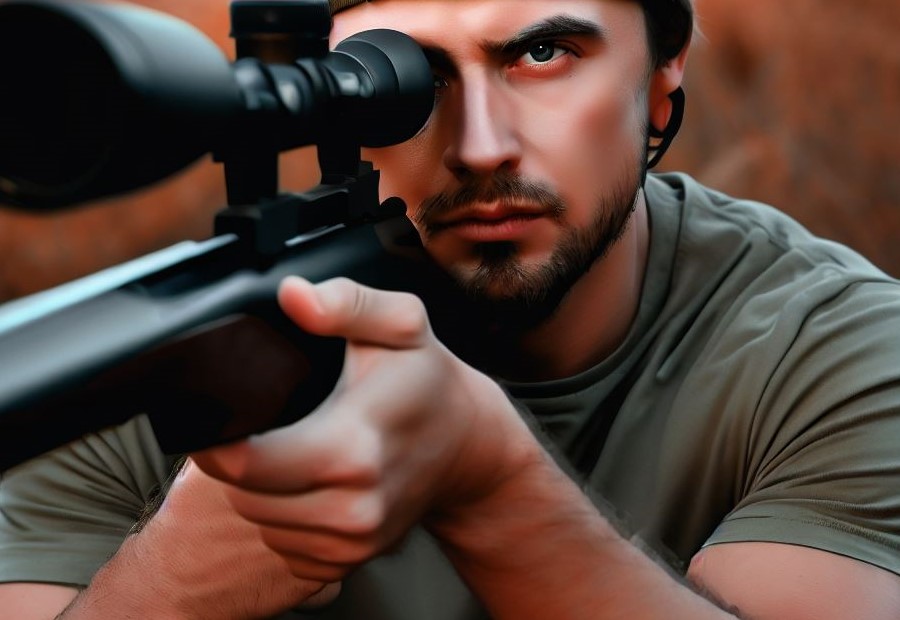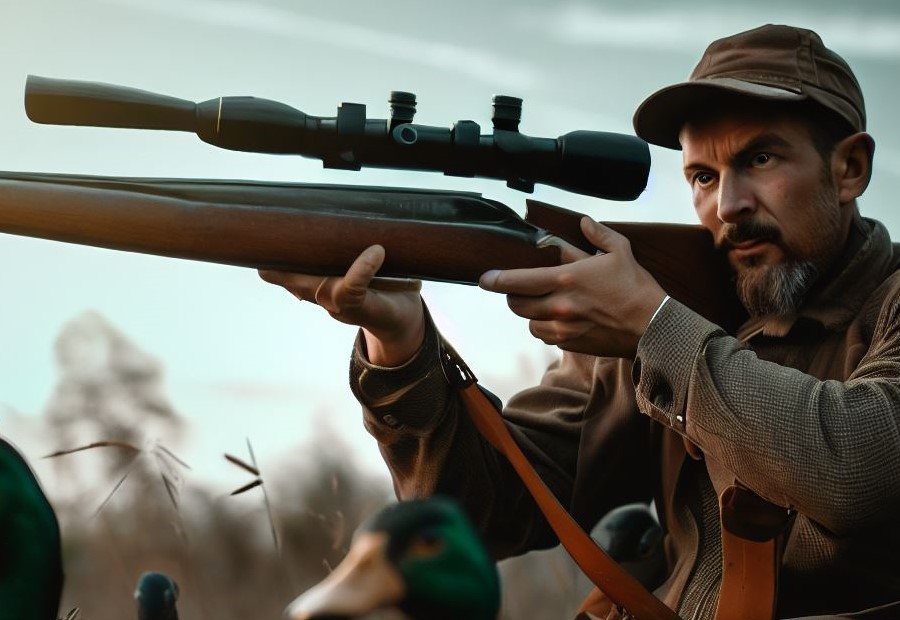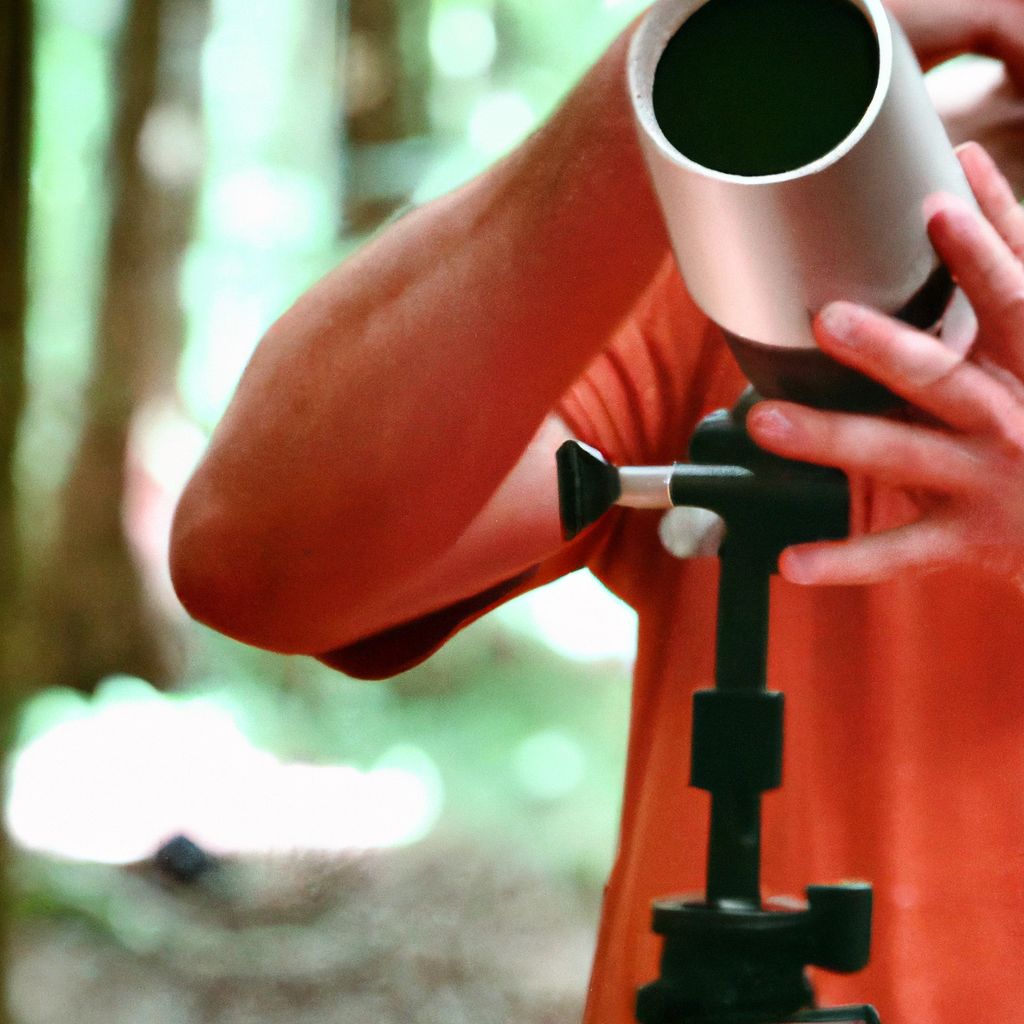Using a rifle scope on a shotgun may seem like a practical solution for improving accuracy and extending shooting range. However, there are several factors to consider before doing so. Understanding the differences between a rifle scope and shotgun scope is essential.
A rifle scope is designed for long-range shooting and offers features such as magnification, target turrets, and bullet drop compensation.
On the other hand, a shotgun scope is specifically designed to withstand the recoil of a shotgun and has a wider field of view for quick target acquisition.
Potential challenges may arise when using a rifle scope on a shotgun. Differences in recoil between rifles and shotguns can affect the durability and performance of the scope.
Eye relief and eye box, which determine the distance at which you can comfortably see through the scope, may not be suitable for shotgun shooting. Parallax adjustment and mounting compatibility are additional factors to consider.
Factors to consider when using a rifle scope on a shotgun include the shotgun gauge and load, the distance at which you will be shooting, and the purpose of shooting.
It is important to ensure that the rifle scope is compatible with the specific shotgun model.
Alternatively, there are other options for shotgun optics. Shotgun-specific scopes are designed to withstand the unique recoil of shotguns and offer features tailored to shotgun shooting.
Red dot sights and holographic sights are also popular options that provide fast target acquisition and are suitable for close to medium-range shooting.
Before deciding to use a rifle scope on a shotgun, it is crucial to thoroughly evaluate the compatibility and consider alternative options that are specifically designed for shotguns. Taking these factors into account will help ensure a safe and effective shooting experience.
Can You Use a Rifle Scope on a Shotgun?

Since both rifles and shotguns are firearms, they have similar mounting systems for attaching scopes. However, it’s important to consider a few factors when using a rifle scope on a shotgun.
- Compatibility: Ensure that the rifle scope fits the mounting system of your shotgun. Some shotguns may require specific adapters or rings to attach the scope properly.
- Eye relief: Rifle scopes are designed with a specific eye relief distance, which is the distance between your eye and the scope. Make sure the eye relief of the scope you choose is suitable for the recoil of your shotgun.
- Field of view: Shotguns usually have shorter effective ranges compared to rifles, so consider using a scope with a wider field of view to accommodate for closer targets.
Understanding the Difference Between Rifle Scope and Shotgun Scope

To gain a comprehensive understanding of the difference between a rifle scope and a shotgun scope, we can compare their key characteristics in a table.
| Rifle Scope | Shotgun Scope |
| Rifles are specifically designed for precise, long-range shooting. | Shotguns, on the other hand, are primarily used for close-range targets such as hunting birds or small game. |
| Rifle scopes provide higher magnification options and longer eye relief to ensure greater accuracy. | Shotgun scopes, however, generally offer lower magnification to accommodate a wider field of view for fast-moving targets. |
| The reticles in rifle scopes are tailored for bullet drop compensation over long distances. | Shotgun scopes often feature reticles with wider crosshairs or dots to facilitate quicker target acquisition. |
| Rifle scopes are built to withstand the recoil produced by high-caliber rifles. | Shotgun scopes, on the other hand, are specifically designed to handle the vibrations caused by shotgun recoil. |
Acquiring a thorough understanding of these differences is crucial when selecting the appropriate scope for your firearm. To emphasize the significance of using the right scope, allow me to share a true story.
One of my friends, who is an avid hunter, once mistakenly mounted a rifle scope on his shotgun. When he went out to hunt birds, he encountered numerous difficulties in acquiring fast targets and accurately judging distances.
The narrow field of view and the reticle designed for bullet drop compensation severely hampered his performance. However, as soon as he switched to a shotgun scope, he noticed a significant improvement in both accuracy and speed.
Remember, selecting the right scope that suits your specific firearm is essential in order to optimize your shooting experience.
What Are the Characteristics of a Rifle Scope?
- Magnification: Rifle scopes have variable or fixed magnification options, allowing the shooter to zoom in on the target for better visibility and accuracy. The magnification ranges can vary from 1x to 40x or even higher.
- Objective Lens Diameter: The objective lens is the one farthest from the shooter’s eye. It determines the amount of light that enters the scope and affects the brightness and clarity of the image. Rifle scopes often have larger objective lenses for better light gathering.
- Reticle: The reticle, which is also known as the crosshair, helps the shooter aim at the target. There are various types of reticles, including duplex, Mil-dot, and BDC (Bullet Drop Compensator), each offering different features and advantages.
- Adjustments: Rifle scopes have adjustment knobs for windage (horizontal) and elevation (vertical) adjustments. These allow the shooter to zero their scope and compensate for bullet drop or wind drift.
- Eye Relief: Rifle scopes have a specific distance, known as eye relief, where the shooter’s eye can be positioned to see the full field of view with their eye relaxed. It is important to consider eye relief to prevent scope eye injuries.
- Tube Diameter: Rifle scopes typically have a tube diameter of 1 inch or 30mm. The tube houses the internal components of the scope and affects durability and light transmission.
What Are the Characteristics of a Shotgun Scope?
- A shotgun scope typically has a lower magnification compared to a rifle scope. This is because shotguns are primarily used for short-range shooting.
- Shotgun scopes have a wider field of view to accommodate the wider spread pattern of shotgun pellets.
- Shotgun scopes often have a shorter eye relief to withstand the recoil of a shotgun. This means that the shooter needs to keep their eye closer to the scope to see the full image.
- Shotgun scopes may have a bigger exit pupil, which allows more light to enter the eye, improving visibility in low light conditions.
- Some shotgun scopes feature a reticle designed specifically for shotguns, with lines or dots to help estimate the distance at which the pellets will spread.
- Unlike rifle scopes, shotgun scopes usually do not have parallax adjustment because the short-range nature of shotgun shooting makes it less critical.
Possible Challenges of Using a Rifle Scope on a Shotgun

When it comes to using a rifle scope on a shotgun, there are some potential challenges to consider.
From differences in recoil to eye relief and eye box, parallax adjustment to mounting compatibility, each aspect presents its own unique set of considerations.
So, before you venture into this territory, let’s unravel these challenges together and explore the possibilities and limitations of using a rifle scope on a shotgun.
Differences in Recoil
| Aspect | Rifle Scope | Shotgun Scope |
| Recoil | Recoil in rifles is generally higher due to the higher velocity and power of rifle cartridges. | Shotguns typically have lower recoil because of the design and lower power of shotgun shells. |
This table showcases the primary difference in recoil between rifle scopes and shotgun scopes.
Rifles generally produce higher recoil due to the increased velocity and power of rifle cartridges.
On the other hand, shotguns have lower recoil because of their design and the lower power of shotgun shells.
Eye Relief and Eye Box
Eye relief and eye box are vital considerations when utilizing a rifle scope on a shotgun.
| Eye Relief | Eye Box | |
|---|---|---|
| Rifle Scope | 3-3.5 inches | Flexible |
| Shotgun Scope | 4-5 inches | Wider, fixed |
The eye relief of a rifle scope generally falls in the range of 3 to 3.5 inches. This means that the shooter must position their eye at a specific distance from the scope to achieve a clear and complete view of the reticle.
Conversely, a shotgun scope typically provides a longer eye relief, usually ranging from 4 to 5 inches. This allows the shooter to position their eye farther from the scope, accommodating the different shooting stance and recoil of shotguns.
Regarding the eye box, a rifle scope offers greater flexibility. This means that the shooter can have a wider variety of eye positions while still maintaining a clear image. This flexibility is crucial for quick target acquisition and follow-up shots.
On the other hand, a shotgun scope has a wider, fixed eye box. Therefore, the shooter must align their eye within a specific area to maintain a clear view.
When using a rifle scope on a shotgun, it is essential to consider the disparities in eye relief and eye box. The shorter eye relief of a rifle scope may not be suitable for the increased recoil and different shooting position of a shotgun.
Furthermore, the fixed eye box of a shotgun scope guarantees a consistent sight picture, which is vital for accurate and rapid shooting.
Parallax Adjustment
When using a shotgun with a rifle scope, one must take into account the parallax adjustment.
This adjustment is vital in maintaining focus on the target and minimizing aiming errors caused by parallax.
| Understanding Parallax Adjustment |
| The parallax adjustment feature allows for correction of the parallax effect. This effect occurs when the reticle and the target seem to be on different planes, resulting in a shift in the point of aim and causing accuracy problems. By using the parallax adjustment on a scope, the shooter can align the reticle and the target on the same focal plane, thereby enhancing the precision of aiming. |
Pro Tip: Opt for a scope with parallax adjustment capabilities when using a rifle scope on a shotgun. This feature will significantly improve accuracy and ensure that your shots hit the intended target.
Mounting Compatibility
To discuss the sub-topic of “Mounting Compatibility” in relation to using a rifle scope on a shotgun, a table can be created to highlight the relevant information.
| Shotgun | Rifle Scope | Mounting Compatibility |
| 12 gauge | Standard rifle scope | May require special mounts or adapters for proper alignment |
| 20 gauge | Standard rifle scope | May require special mounts or adapters for proper alignment |
| .410 bore | Standard rifle scope | May require special mounts or adapters for proper alignment |
It is important to note that mounting compatibility between a rifle scope and a shotgun may vary based on the specific make and model of both the firearm and the scope.
In some cases, standard rifle scopes can be mounted on shotguns, but they may require special mounts or adapters for proper alignment.
These mounting accessories ensure that the scope is securely attached to the shotgun and maintains proper alignment, allowing for accurate aiming and shooting.
When considering mounting compatibility, it is crucial to consult the manufacturer’s recommendations for both the rifle scope and the shotgun to ensure compatibility and avoid any potential issues or damage to the equipment.
Additionally, seeking professional advice or assistance from a knowledgeable gunsmith can provide valuable insights and guidance on achieving optimal mounting compatibility.
Factors to Consider when Using a Rifle Scope on a Shotgun

Considering factors such as shotgun gauge and load, distance and purpose of shooting, and scope compatibility, using a rifle scope on a shotgun requires careful consideration.
With different sub-sections dedicated to each factor, we will explore the crucial elements that must be taken into account when using a rifle scope on a shotgun.
So, if you’re wondering about the feasibility and effectiveness of such a combination, join us as we delve into the world of shotgun scopes and the important factors to keep in mind.
Shotgun Gauge and Load
| Shotgun Gauge | Appropriate Load |
| 12 Gauge | With a variety of loads available, the 12 Gauge is the most commonly used gauge. It is suitable for various shooting purposes such as hunting and sport shooting. |
| 20 Gauge | Being a lighter gauge with slightly less recoil, the 20 Gauge is suitable for smaller game hunting and sport shooting. |
| 16 Gauge | The 16 Gauge is a less common gauge with limited load options. However, it is suitable for hunting small to medium-sized game. |
| 28 Gauge | The 28 Gauge is a smaller gauge with lighter loads, making it suitable for hunting small game and recreational shooting. |
| .410 Bore | With low recoil and being the smallest shotgun gauge, the .410 Bore is suitable for hunting small game and beginner shooters. |
Pro-tip: When selecting the appropriate load for your shotgun, consider factors such as the shooting distance, target, and purpose. Different loads can vary in terms of pellet size, velocity, and shot pattern, which can affect your shooting performance and effectiveness. It’s important to choose a load that matches your shooting needs to ensure optimal results.
Distance and Purpose of Shooting
When considering the distance and purpose of shooting, there are several factors that should be taken into account.
| Distance | Purpose of Shooting |
| Short Range | Hunting small game |
| Medium Range | Hunting larger game |
| Long Range | Precision shooting or long-range hunting |
When shooting at short range, such as when hunting small game, a rifle scope with lower magnification would be suitable. It allows for a wider field of view, making it easier to track fast-moving targets.
For medium-range shooting, when hunting larger game, a scope with moderate magnification would be ideal. This provides a balance between magnification and field of view.
When engaging in precision shooting or long-range hunting, a scope with high magnification is necessary to accurately aim at targets that are farther away. These scopes often have features like adjustable turrets for dialing in the correct elevation and windage settings.
It is important to choose a scope that is appropriate for the purpose of shooting. Using a scope with insufficient magnification or limited features can negatively impact accuracy and effectiveness.
Remember to consider the distance you will be shooting and the specific purpose of your shooting activities when selecting a rifle scope.
Scope Compatibility with Shotgun
| Factors to Consider for | |
| Mounting System | A single-piece mount with rigid construction is recommended for better scope compatibility with shotguns. This ensures stability and proper alignment with the shotgun’s receiver. |
| Recoil Resistance | The scope should be able to withstand the recoil generated by the shotgun. Look for scopes specifically designed for shotguns or those with reinforced construction to handle the heavy recoil. |
| Eye Relief | Adequate eye relief is crucial to prevent any scope-related injuries. Opt for a scope with a longer eye relief to maintain a safe distance between your eye and the scope, considering the shotgun’s recoil. |
| Reticle Type | Choose a reticle that suits your shooting style and preferences. For shotguns, a wider reticle like a duplex or a shotgun-specific reticle can help with faster target acquisition and improved accuracy. |
| Field of View | A wider field of view allows for better situational awareness, especially in dynamic shooting scenarios. Consider scopes with a larger objective lens and lower magnification to enhance the field of view. |
When selecting a scope for your shotgun, ensure compatibility by considering the scope compatibility with shotgun, mounting system, recoil resistance, eye relief, reticle type, and field of view.
A sturdy mounting system ensures stability, while recoil resistance prevents damage to the scope.
Opting for a scope with longer eye relief adds a safety margin during recoil. Choosing a suitable reticle type enhances your shooting experience, and a wider field of view improves situational awareness.
By considering these factors, you can find a scope that performs optimally with your shotgun, enhancing your shooting abilities.
Alternative Options for Shotgun Optics

Looking for alternative options to enhance your shotgun’s optics? Look no further! In this section, we’ll explore a range of options that will take your shotgun game to the next level.
From specialized scopes designed specifically for shotguns, to the versatility of red dot sights, and the futuristic holographic sights, we’ve got you covered. Get ready to discover the perfect optic solution for your shotgun needs.
Shotgun-Specific Scopes
When it comes to using scopes on shotguns, shotgun-specific scopes have some distinct advantages:
- Design: Shotgun-specific scopes are specifically designed to withstand the recoil and vibrations generated by shotguns. They are built with durable materials and reinforced construction to handle the unique characteristics of shotgun shooting.
- Wide Field of View: Shotgun-specific scopes offer a wider field of view compared to rifle scopes. This is beneficial for fast-moving targets and close-range shooting encountered in shotgun hunting or competitive shooting.
- Eye Relief: Shotgun-specific scopes provide generous eye relief, allowing shooters to maintain a comfortable shooting position and avoid the risk of scope eye injuries caused by heavy recoil.
- Reticle Types: Shotgun-specific scopes often feature specialized reticle designs such as shotgun-specific reticles or illuminated reticles tailored to the patterns of shotgun loads.
Pro-tip: When choosing shotgun-specific scopes, make sure to consider the gauge and load you will be using, as well as the distance and purpose of your shooting. This will help you select a scope that is optimized for your specific needs and ensures the best performance on your shotgun.
Red Dot Sights
When considering alternative options for shotgun optics, one popular choice is red dot sights. These sights offer several advantages for shotgun shooters:
- Fast target acquisition: Red dot sights provide a simple and intuitive aiming solution. With a large, illuminated dot reticle, shooters can quickly locate and aim at their targets.
- Unlimited eye relief: Unlike traditional scope designs, red dot sights have unlimited eye relief. This means shooters can maintain a comfortable shooting position regardless of the distance between their eyes and the sight.
- Parallax-free aiming: Red dot sights are parallax-free, which means the reticle remains aligned with the target regardless of the shooter’s eye position. This makes it easier to stay on target and maintain accuracy.
- Compact and lightweight: Red dot sights are typically smaller and lighter than rifle scopes, making them a great choice for shotguns, which can already be heavy and bulky. Their compact size also makes them more maneuverable in close-quarters shooting situations.
Pro-tip: When selecting a red dot sight for your shotgun, consider the size of the sight’s dot reticle. A larger dot can be advantageous for fast-paced shooting scenarios, while a smaller dot may provide better precision for longer-range shots.
Holographic Sights
When it comes to shotgun optics, one alternative to traditional rifle scopes and red dot sights is the use of holographic sights.
Holographic sights offer high levels of accuracy due to their holographic reticle technology. These sights provide a clear and crisp sight picture, even in low-light conditions.
They also allow for quick target acquisition and engagement, making them suitable for scenarios that require fast response times. Unlike other sights, holographic sights are not affected by the shooter’s eye position, allowing for increased flexibility and ease of use.
Additionally, these sights are designed to be parallax-free, minimizing sighting errors caused by shifts in the shooter’s position. Many holographic sights are built with rugged materials and are resistant to shock, water, and harsh weather conditions.
While holographic sights can be a great option for shotgun optics, it’s important to ensure that they are compatible with your specific shotgun model and gauge.
It is also essential to consider your shooting distance and intended purpose to determine if a holographic sight is the right choice for you.
Frequently Asked Questions
Can you use a rifle scope on a shotgun?
Yes, it is possible to mount a rifle scope on a shotgun. However, it is not recommended due to the recoil that can potentially break the scope or cause injury.
What are the differences between shotgun scopes and rifle scopes?
Shotgun scopes and rifle scopes have differences in terms of field of view, distance, and recoil. Shotgun scopes typically have a larger field of view and extended eye relief to withstand shotgun recoil, while rifle scopes offer better magnification for shooting targets at farther distances.
What factors should I consider when choosing a shotgun scope?
When choosing a shotgun scope, it is important to consider factors such as eye relief, durability, magnification levels, type of sight (such as red dot or holographic), inconspicuousness to wildlife, and lens clarity.
Can I use a rifle scope for bird hunting with a shotgun?
There is a debate on whether optical sights, such as red dot or holographic sights, are useful for bird hunting with shotguns. Some argue that these sights make judging the proper lead easier and more instinctive, while others rely on experience and feel.
It is suggested to try both ways and see what works best for individual preference and experience.
Can I mount a shotgun scope on any shotgun?
Not all shotguns are equipped for scope mounting, and specialized mounting systems or assistance from a gunsmith may be required. It is important to check if your shotgun has the necessary scope rail or base to mount a shotgun scope.
What are slug scopes and when are they used?
Slug scopes are scopes designed specifically for use with slug-barreled shotguns. Slugs are large, heavy projectiles used in slug guns for hunting large game.
Some states only allow hunting with slug shotguns, and mounting a slug scope can improve accuracy and precision for hunting deer, turkeys, and other large game.

